FRAME FINISHING
How
the surface of the timber in a frame is finished is entirely the choice
of the client. There are cost implications and a number of choices with
some grey areas in between!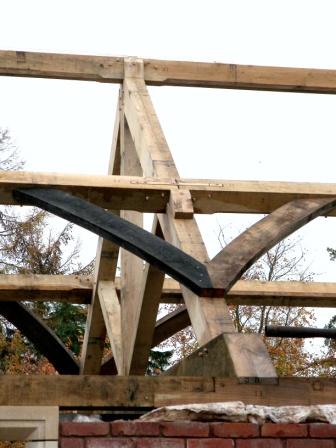
This
decision is another of the many that have to be made at the design and
pricing stage, because once the timber is ordered or the framing has
begun certain options may become impossible.
It should be remembered that a timber frame is primarily a structural component of a building and that the tradition has developed on this basis. Therefore the norm is for the carpenter to treat it as such. The
standard finish on a frame when it is erected on site, is a bandsawn
finish which is exactly how it comes from the saw mill. This is quite
rough with the saw marks running across the piece. Also usually there
will be stains due to contact with ferric metals, and graying of timbers
(a exceptionally bad example of this on the right) due to air-drying in
the open. There will have been no attempt to keep the timber clean or
free of pencil marks, etc. by the carpenter, because the default
expectation is that the frame will be sandblasted or otherwise cleaned
by the client or their agent after the roof is watertight, at which point
there is minimal risk of the timber being stained again.
So first of all we'll look at sandblasting.
Sandblasting
– The most common cleaning method. If done well it produces a very
uniform look, with a slight lightening of colour and a deeper grain
texture. If overdone it can make the wood look like "comedy Disney
driftwood" in Kevin McClouds words. 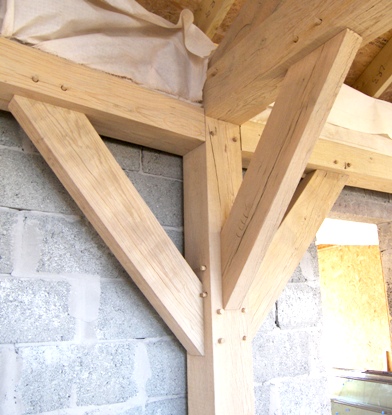 Many companies have never
sandblasted green oak before so choose with care. The
sandblaster is usually engaged directly by the client or his/her agent
since the blasting takes place sometimes months after the framer has
left site, when the roof is watertight but before any glazing or
internal finishes or plasterboard are in place (these can be damaged by
the blasting). Occasionally some stains in the wood still show through
and can not be removed but these mellow as the years pass - after all
wood is a natural material and to aim for perfect uniformity is not
realistic. On the other hand it will remove the darker grey surface often found on
the air dry curves which is most difficult to achieve by all other
methods (except planing).
Many companies have never
sandblasted green oak before so choose with care. The
sandblaster is usually engaged directly by the client or his/her agent
since the blasting takes place sometimes months after the framer has
left site, when the roof is watertight but before any glazing or
internal finishes or plasterboard are in place (these can be damaged by
the blasting). Occasionally some stains in the wood still show through
and can not be removed but these mellow as the years pass - after all
wood is a natural material and to aim for perfect uniformity is not
realistic. On the other hand it will remove the darker grey surface often found on
the air dry curves which is most difficult to achieve by all other
methods (except planing).
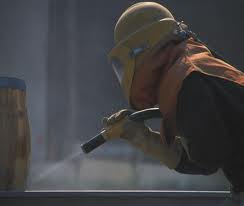 Great care must be exercised in the selection of the grit used as the
wrong type will turn the whole frame blue/gray due to a reaction with
the tannins in the wood! This has happened on more than one occasion to
my knowledge (not to my frames I’m pleased to say) and was rather
shocking for the clients to say the
least.
Great care must be exercised in the selection of the grit used as the
wrong type will turn the whole frame blue/gray due to a reaction with
the tannins in the wood! This has happened on more than one occasion to
my knowledge (not to my frames I’m pleased to say) and was rather
shocking for the clients to say the
least.
It is not really possible to sandblast softwoods (larch & douglas
fir).The
cost usually works out around £1000 for a day (medium sized extension),
and £1600 for two days (3 bedroom house) but you are advised to get a
quote at budgeting time. It is very messy and plenty of allowance should
be made for clearing up, including compressed air to flush the dust out
of joints in the frame.
There are a couple of experienced companies on
the links page.
Ice blasting – This is done using frozen CO2 crystals which just evaporate after they contact the wood. It is a bit of a new method of cleaning frames but shows promise in the cases where it has been used, giving a much less pitted finished surface than the sand. However it seems to be rather more expensive. Also it's best to know if you are considering this before the carpentry starts in the workshop. I don’t have any recommendations at present.
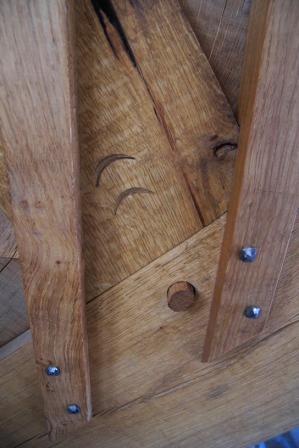
Planing and oiling - Planing a frame is done in the workshop by the framer. The oil then
prevents the surfaces from becoming too badly stained or marked again
during site erection and subsequent build. Usually though a final cleaning and maybe retouching with oil will be necessary when the rest of the trades have finished work
and there is no more risk of contamination, since it is near impossible
to keep the frame completely clean. The finish on a planed frame is not
like a piece of furniture. Because of the size of the timbers, and the equipment used, there
will always be some planing marks, and minor ripping out of the grain,
and of course the timber will continue moving for years after
installation with shakes and checks making the surface rougher and quite
uneven.
The oil used is a mixture of linseed oil and natural turpentine and makes the frame shinier and darker. A planed frame results in a much less authentic look as it is not a traditional practice. It also has a considerable cost implication which varies according to the size and type of frame.
Doing nothing
– This option is also common. The only thing is it isn’t really “doing
nothing”, in fact it can be “doing quite a lot” as I will explain below.
It can however be quite cheap and aesthetically it is liked by many
clients being regarded as honest and also well suited to the heavy
sections of timber. It is also the closest one can feasibly get to a
traditional finish, short of spending the extra on hewing or pit sawing,
which is often particularly relevant to those who have lived in or near
historic timber frames.
Firstly
the carpenter must minimise the marks and dirt left on the timber after
framing, and if it is oak being used, remove the worst of the metal
staining using oxalic acid (this staining is a reaction of the tannins
in the oak to contamination by ferric metals in the milling and handling
of the timbers). The best attempt is then made to keep the timbers as
clean as possible during transport and erection, and also afterwards
when the client or their agent must be responsible for preventing
further staining due to tools being left on the timber etc.. Finally at
an appropriate moment in the build, maybe just before any decoration
takes place, the frame is scrubbed down with water and possibly oxalic
acid,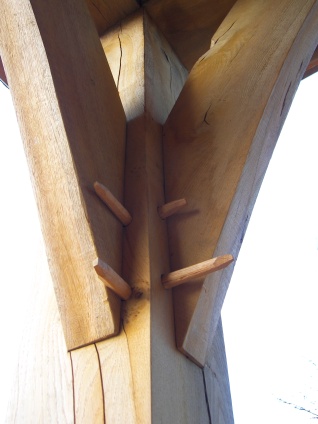 and/or gently sanded by the client or the builder. Pressure
washing could be slipped in at some earlier stage as well to help clean
off mud and other ingrained dirt.
and/or gently sanded by the client or the builder. Pressure
washing could be slipped in at some earlier stage as well to help clean
off mud and other ingrained dirt.
The
process described above can be varied according to tastes with some
preferring to leave the frame as built with all the carpenters pencil
marks etc. and some finding it hard to stop working away at it. A really homogenous finished result will never be achieved though because the sawn surface means that some staining or silvering and other marks will always
remain in the dip of each saw cut. And any air-dry curves used in the
frame will retain much of their grey surface colour. This is not
necessarily to the detriment of the frame though it just depends on
personal taste.
Hand hewing
– This is not really a finishing method, it is the way most timber frames were 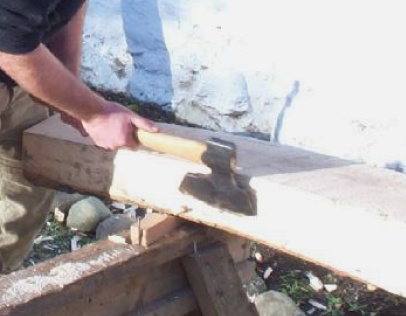 converted from the round log into a square or rectangular section up until the modern
era, but it does result in a characteristic undulating surface texture and is nowadays usually employed as a finishing technique.
My own 19th century dormer cottage in Angus has a roof of baltic fir
rafters hand hewn on most faces, the others having been sawn. The reason some faces are hewn and some
sawn is to do with the particular method of conversion from log, to
beam, to smaller sections (in my case rafters).
converted from the round log into a square or rectangular section up until the modern
era, but it does result in a characteristic undulating surface texture and is nowadays usually employed as a finishing technique.
My own 19th century dormer cottage in Angus has a roof of baltic fir
rafters hand hewn on most faces, the others having been sawn. The reason some faces are hewn and some
sawn is to do with the particular method of conversion from log, to
beam, to smaller sections (in my case rafters).
Historically it was not done with an adze (a common misconception), but with an axe, and
gives an unmistakeable “rough but smooth” undulating finish. It
is done by the framer in the workshop and is very time 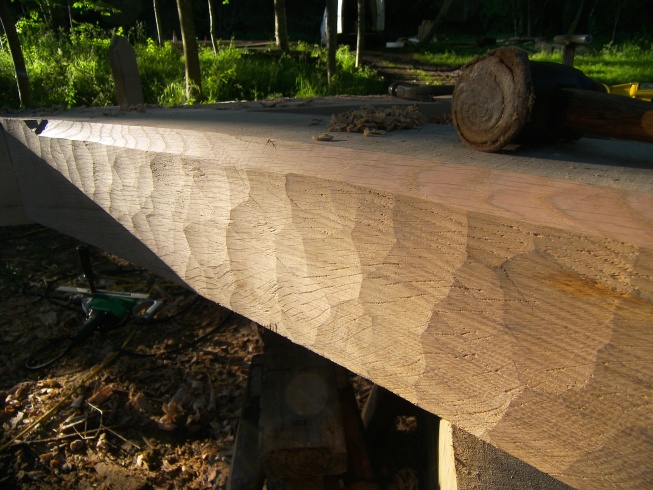 consuming to do,
so therefore quite expensive, but a frame of timber converted or finished with an axe is the real deal! Having said that the
traditional conversion tool was the axe, I should add that the adze can
be used as a finishing tool and makes a rather tidier and very
attractive finished surface. I would not want to discount it as an
option just for fear of attack by the purists of the framing world, who
would remind us that it was not much used traditionally in frames, after
all the sand blasting compressor was not used traditionally either!
However one could not really term adzing a traditional hewn finish for a timber frame.
consuming to do,
so therefore quite expensive, but a frame of timber converted or finished with an axe is the real deal! Having said that the
traditional conversion tool was the axe, I should add that the adze can
be used as a finishing tool and makes a rather tidier and very
attractive finished surface. I would not want to discount it as an
option just for fear of attack by the purists of the framing world, who
would remind us that it was not much used traditionally in frames, after
all the sand blasting compressor was not used traditionally either!
However one could not really term adzing a traditional hewn finish for a timber frame.
~
There
is no need to oil or stain or otherwise treat a traditional timber
frame although some people do, usually because it imparts a
slightly darker color to the wood. Varnishes and paints and other surface coverings that form a separate layer will simply
fall off in the first years whether they are brittle or flexible, because of the shrinkage. No insecticidal or fungicidal treatments need be applied to the heartwood (which is 95% of the wood) and if, as occasionally happens, any woodworm take up residence in the sapwood (lighter colored wood on the edges of the timbers) a localised application of a boron based insecticide is usually very effective. There is more on this on the "about oak frames" main page.
Whichever
of the finishes above is chosen, because wood is a natural material,
colour variations will still exist between pieces, and sometimes blue
metal stain will remain due to pieces of metal actually being embedded
in the wood, such as fencing or nails, or shrapnel in the case of French
oak (actually quite common). All these usually become less noticeable
with time.
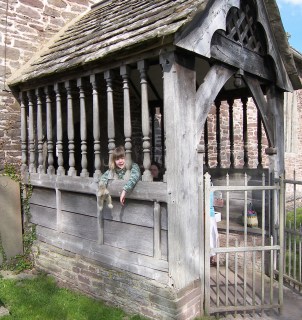 Colour: All
timbers exposed to the elements will take on a silvery gray appearance
after a few years, like the old porch on the left, while those enclosed by the envelope of the building
will mellow but remain fairly unchanged. Oak and sweet chestnut might
darken a little, douglas fir and larch will darken and loose some of
their pinkness, becoming a warm orangey brown.
Colour: All
timbers exposed to the elements will take on a silvery gray appearance
after a few years, like the old porch on the left, while those enclosed by the envelope of the building
will mellow but remain fairly unchanged. Oak and sweet chestnut might
darken a little, douglas fir and larch will darken and loose some of
their pinkness, becoming a warm orangey brown.
As
mentioned above, thinner sections of curved oak such as braces (up to
4” stock usually), will be of air-dry oak, unless otherwise specified,
for reasons of structural strength and aesthetics related to shrinkage.
This is best practice but does result in one drawback, namely that the
surface colour is sometimes a darkish grey which can be regarded as
unattractive if the frame is not going to be sandblasted or planed which
would remove this colouring. The braces can be specified as green wood,
but if this is going to be the case it should be discussed at the
design stage, since it is best to instigate one or more changes to the
design, to mitigate the possible effects.
If
the frame is of oak, then when the frame is first erected and the rain
comes bucketing down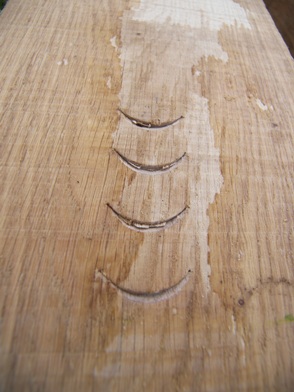 , as it usually does at some point, the tannins will
begin to wash out of the wood and create tannin run-off stains on the
wood surface (called tide marks), and on the masonry footings etc. The
tide marks will be removed by cleaning/sand-blasting the frame when the
building is water-tight, but the ones on the outside masonry are not
worth removing since they will soon be replaced by more. However this
process does not continue for more than a year or so, after which the
stains will begin to fade and eventually disappear. If it is essential
to remove the stains that occur on masonry in the first year then there are ways of doing this
depending on the masonry or render material. Please contact me if you
need advice on this.
, as it usually does at some point, the tannins will
begin to wash out of the wood and create tannin run-off stains on the
wood surface (called tide marks), and on the masonry footings etc. The
tide marks will be removed by cleaning/sand-blasting the frame when the
building is water-tight, but the ones on the outside masonry are not
worth removing since they will soon be replaced by more. However this
process does not continue for more than a year or so, after which the
stains will begin to fade and eventually disappear. If it is essential
to remove the stains that occur on masonry in the first year then there are ways of doing this
depending on the masonry or render material. Please contact me if you
need advice on this.
One more type of stain. If the frame is of douglas fir or larch or indeed any softwood it can be affected by bluestain fungus, which is harmless but covers the sapwood with lots of little blue spots. It mainly affects the sapwood (the lighter wood) and it fades with time when in a dry environment.
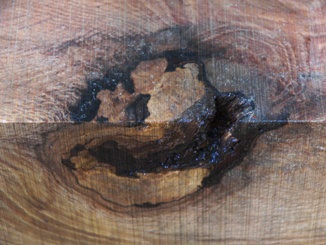 J. Rose Carpentry
J. Rose Carpentry